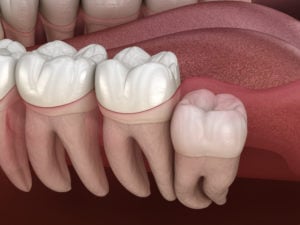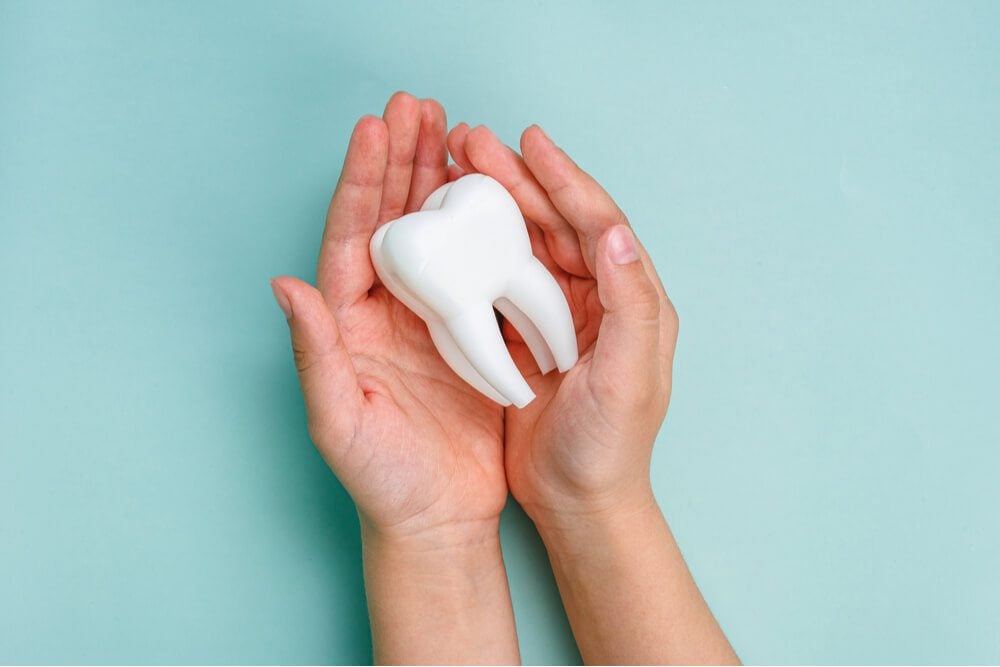Wisdom teeth are third molars that are the last to grow in, around 17-21 years.
Most people have to get their wisdom teeth removed if there isn’t enough room in the mouth or if these molar are growing in incorrectly. These pesky molars can cause pain due to impaction or other problems such as decay or gum disease. This is because wisdom teeth are so far back in the mouth that many people struggle to clean them properly.
Wisdom teeth removal is a surgical procedure that requires about 3-4 days of post-operative recovery. And if the case is more complex, it may take up to 2 weeks for a full recovery.
How painful is wisdom teeth removal?
You may experience mild pain, discomfort, and swelling for a few days after wisdom teeth removal. Depending on how involved the surgery was, you should be feeling better in about 3-7 days, unless you experience any complications, such as dry socket,
How much time should I take off from work?
Generally, we say to take about 2-3 days off of work to heal and recover. It’s crucial to strictly follow the post-operative instructions your doctor gives you to allow proper healing.
What to expect: day of surgery
Because only a local anesthetic will be used for the procedure, you can drive yourself to and from your appointment. However, if you decide to get sedation, you will need a driver that day.

The procedure should take roughly an hour, depending on the case’s complexity and how many teeth will be extracted. If you’re receiving sedation, it will require more time before and after the procedure.

Going home
On the first day, you will still be numb for the first couple of hours. But as the anesthesia wears off, you may feel some mild pain. Your surgeon may give you a prescription for pain medication and antibiotics, which you can start taking that day. But you may only need over-the-counter pain killers, which you should probably take as soon as you get home.
Make sure to rest and take it easy that day and avoid any strenuous activity.
Your surgeon will send you home with gauze to bite on and change out every 30 minutes to stop the bleeding.
You can use an ice-pack to reduce the swelling on the side of the face, where the tooth was pulled, for increments of 20 minutes on and 20 minutes off.
You may also experience nausea and vomiting, depending on the type of sedation you’ve had or if you react to the medication. If this continues after the first 10 hours, give your dentist a call.
Wisdom teeth care: do’s and don’ts
Do the following:
- Take the pain medications and antitbiotics as soon as possible after the surgery (and with food).
- Change out the gauze every 30 minutes to an hour. You can stop after 2-3 hours or when your surgeon says to.
- Use an ice-pack to reduce swelling for the first 24-36 hours after surgery.
- Use moist heat to reduce inflammation after the first 36 hours.
- Eat soft foods only.
- Drink plenty of water and fluids (do not use a straw)
- Start brushing your teeth after 24 hours – avoiding the extraction site.
- sleep with an extra pillow to keep your head elevated.
DO NOT do the following:
- Brush your teeth, floss, or use mouthwash for the first 24 hours after surgery.
- Touch around the extraction site
- remove the gauze except for when replacing it.
- spit or rinse your mouth vigorously
- drink through a straw for 3 days
- smoke for 7 days
- drink alcohol.
- drive or operate heavy machinery for 48 hours.
- eat hard, sticky, crunchy or sugary foods.
- exercise or perform any strenous activities for 3-4 days.
Tips to prevent dry socket:
Tips for a fast recovery after wisdom teeth removal
- Prevent dry socket.
- Rinse gently with warm salt water after the first 48 hours.
- Intermittently ice the sides of your face for the first 36 hours.
- keep your head elevated for the first 36 hours.
- Stay hydrated and reduce inflammation.
- Don’t let your mouth dry out.
- Eat soft healthy foods
- Rest as much a possible.
- Gently massage your jaw with a warm compress.
- Take Vitamin C.
How to prevent dry socket
One of the most important things for healing after wisdom teeth removal is preventing dry socket. This is a painful phenomenon when the healing clot gets dislodged, and the bone underneath is exposed.
Dry socket occurs in about a quarter to a third of wisdom teeth removal cases and happens within the first two to three days after surgery.
Your surgeon or dentist will give you post-operative instructions to follow. Make sure to diligently follow these instructions to help prevent dry socket.
Here are the best ways to prevent dry socket:
- Do not smoke for at least a week
- Do not perform any spitting, vigorous rinsing, or sucking motion of any kind
- Do not drink through a straw
- Do not soak the gauze in water before placing them in the mouth.
- Take your antibiotics as your doctor prescribes.
- Eat only soft foods.
- Avoid vigorous kissing or any othr vigorous mouth movement.
Elevate your head
You want to keep your head elevated for the next couple of days. Sleep with an extra pillow to prevent lying flat. When you lie flat, the blood vessels tone and blood volume increase in the affected area, leading to to more swelling and throbbing.
Ice your face
The first 36 hours, after your surgery, you want to ice the sides of your face to help reduce pain and swelling. This will help you heal faster for the rest of the healing time. Ice intermittently, for 20 minutes on and 20 minutes off, as much as you can for the first 36 hours.
Rinse with warm salt water
You want to keep the extraction site clean and free of debris and bacteria for optimal healing. Gently rinse with warm salt water several times a day. This also helps soothe the gums, prevent gum inflammation, and fight off bacteria.
Reduce inflammation
For the first 48 hours, inflammation is at its peak. You want to control the inflammation, which controls pain, by taking anti-inflammatories such as ibuprofen and tylenol (often together) to effectively reduce inflammation.
Be cautious with medication
You may experience nausea and vomiting after your surgery due to the anesthetics and medication. Be cautious not to overuse medication, which can lead to worsening nausea and vomiting. Try to take as little medication as possible, and avoid taking medications on an empty stomach. Try to stay hydrated and eat soft foods to stay nourished while you’re healing.
How long is the recovery for wisdom teeth removal?
You should recover from wisdom teeth removal in about 3-4 days. And for impacted teeth, the recovery time may take up to a week. It takes about 2 weeks for most of the swelling and bruising to subside. By 3 months, the extraction site is fully healed.
When to call your dentist
If you experience any of the following, call your dentist or surgeon right away:
- excessive bleeding that doesn’t subside after 4 hours post-surgery.
- excessive pain that doesn’t subsdie with medication.
- Pain that peaks after 10 hours.
- fever and chills
- nauseau and vomitting more than 10 hours after surgery.
- chest pain
- shortness of breath
- oozing puss
- vomitting large amounts of blood
- coughing
- difficulty breathing
- difficulty swallowing
- increased swelling over time
- blood or pus from your nose
In conclusion
To summarize, wisdom teeth removal is a common surgery that most people need due to the wisdom teeth growing in incorrectly or because there isn’t enough room in the mouth. Many people end up eventually removing their wisdom teeth because they are difficult to maintain, leading to due to decay, gum disease, and/or infection.
This procedure requires about 3-4 days of post-operative recovery. And if the case is more complex, it may take up to 2 weeks for a full recovery. It’s crucial to strictly follow the post-operative instructions your doctor gives you to allow fast and proper healing.
Got wisdom teeth to remove? Call or come in anytime for a free wisdom teeth consultation!
by Dr. Christine Coughlin DDS
Learn More:
Tooth Extraction – cost, what to expect, procedure, aftercare & recovery



